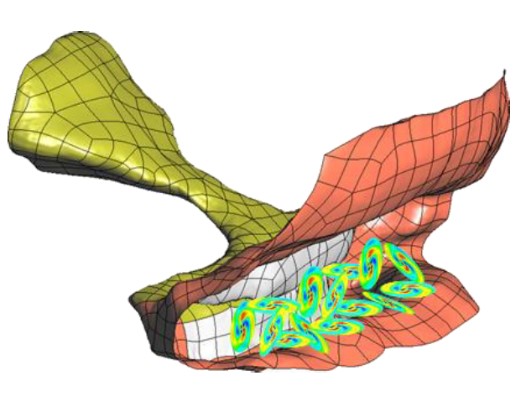Finite element generation of sibilants /s/ and /z/ using random distributions of Kirchhoff's vortices

The generation of sibilant sounds like /s/ is essentially an aeroacoustics phenomenon in which the turbulent eddies passing through the interdental space generate acoustic waves, which get partly radiated outwards and partially diffracted by the teeth. The simulation of sibilants using computational aeroacoustics (CAA) methods demands high-performance computing because both the flow field and the acoustic one need to be resolved. However, the bottleneck is the former which implies solving the non-linear Navier-Stokes equations for the flow motion. To avoid that costly step, researchers from the GTM, Dr. Arnau Pont (currently at Amphos21) Dr. Oriol Guasch and Dr. Marc Arnela recently proposed to substitute the acoustic source term derived from the flow dynamics calculation by an analogue random distribution of Kirchhoff’s vortices. In this way, audible files of /s/ and /z/ can be generated by solving the wave equation in a three-dimensional vocal tract in a laptop avoiding supercomputing facilities.
Details on this research can be found in the paper:
Arnau Pont, Oriol Guasch and Marc Arnela (2020), "Finite element generation of sibilants /s/ and /z/ using random distributions of Kirchhoff's vortices". International Journal for Numerical Methods in Biomedical Engineering, 36 (2), e3302, pp. 1-20.
(https://onlinelibrary.wiley.com/doi/abs/10.1002/cnm.3302)
with abstract:
The numerical simulation of sibilant sounds in three-dimensional realistic vocal tracts constitutes a challenging problem because it involves a wide range of turbulent flow scales. Rotating eddies generate acoustic waves whose wavelengths are inversely proportional to the flow local Mach number. If that is low, very fine meshes are required to capture the flow dynamics. In standard hybrid computational aeroacoustics (CAA), where the incompressible Navier-Stokes equations are first solved to get a source term that is secondly input into an acoustic wave equation, this implies resorting to supercomputer facilities. As a consequence, only very short time intervals of the sibilant can be produced, which may be enough for its spectral characterization but insufficient to synthesize, for instance, an audio file from it, or a syllable sound. In this work, we propose to substitute the aeroacoustic source term obtained from the computational fluid dynamics (CFD) in the first step of hybrid CAA, by a random distribution of Kirchhoff's spinning vortices, located in the region between the upper incisors and the lower lip. In this way, one only needs to solve a linear wave equation to generate a sibilant, and therefore avoids the costly large-scale computations. We show that our proposal can recover the outcomes of hybrid CAA simulations in average, and that it can be applied to generate sibilants /s/ and /z/. Modeling and implementation details of the Kirchhoff's vortex distribution in a stabilized finite element code are discussed in the paper, as well as the outcomes of the simulations.

Basic idea of the proposal: instead of solving the Navier-Stokes equations to determine the acoustic source terms from the flow motion, we impose a random distribution of Kirchhoff’s vortices at the area where most eddies occur.